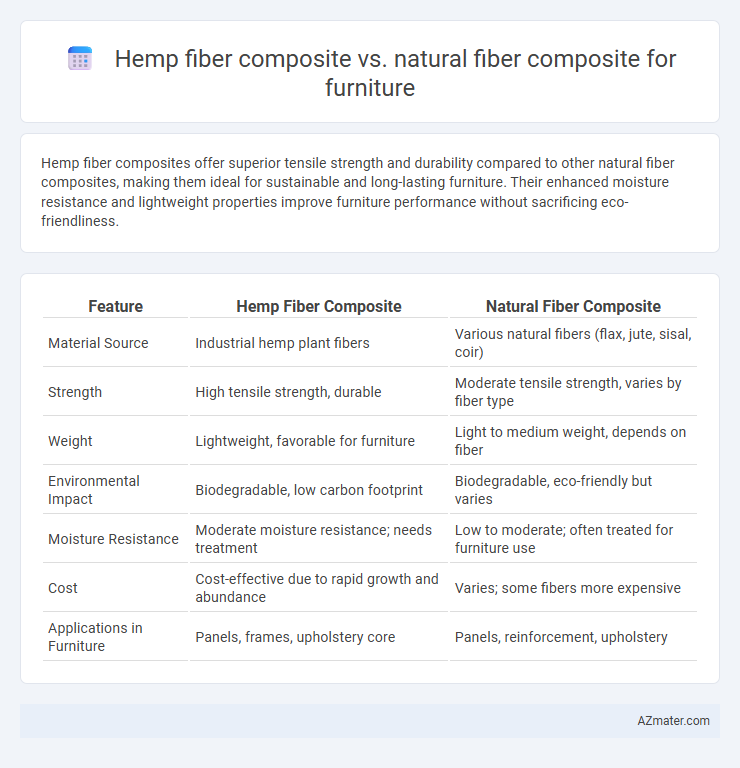Hemp fiber composites offer superior tensile strength and durability compared to other natural fiber composites, making them ideal for sustainable and long-lasting furniture. Their enhanced moisture resistance and lightweight properties improve furniture performance without sacrificing eco-friendliness.
Table of Comparison
| Feature | Hemp Fiber Composite | Natural Fiber Composite |
|---|---|---|
| Material Source | Industrial hemp plant fibers | Various natural fibers (flax, jute, sisal, coir) |
| Strength | High tensile strength, durable | Moderate tensile strength, varies by fiber type |
| Weight | Lightweight, favorable for furniture | Light to medium weight, depends on fiber |
| Environmental Impact | Biodegradable, low carbon footprint | Biodegradable, eco-friendly but varies |
| Moisture Resistance | Moderate moisture resistance; needs treatment | Low to moderate; often treated for furniture use |
| Cost | Cost-effective due to rapid growth and abundance | Varies; some fibers more expensive |
| Applications in Furniture | Panels, frames, upholstery core | Panels, reinforcement, upholstery |
Introduction to Hemp Fiber Composites
Hemp fiber composites offer exceptional strength-to-weight ratios and enhanced durability compared to traditional natural fiber composites, making them ideal for sustainable furniture applications. The cellulose-rich hemp fibers are lightweight yet provide superior tensile strength and impact resistance, improving overall product longevity. Advanced resin matrices combined with hemp fibers result in eco-friendly, biodegradable furniture components that reduce environmental impact without sacrificing performance.
Overview of Natural Fiber Composites
Natural fiber composites, including hemp fiber composites, are increasingly favored in furniture manufacturing due to their renewable, biodegradable, and lightweight properties combined with good mechanical strength. These composites utilize fibers derived from plants such as flax, jute, sisal, and hemp, which offer enhanced sustainability compared to synthetic fibers while maintaining durability and aesthetic appeal. Natural fiber composites improve environmental impact through reduced carbon footprint, better recyclability, and lower energy consumption during production, making them a popular choice for eco-friendly furniture design.
Material Composition and Sources
Hemp fiber composites utilize hemp fibers derived from the stalks of the Cannabis sativa plant, combined with bio-based or synthetic resins to create a strong, lightweight material favored in sustainable furniture design. Natural fiber composites encompass a broader range of plant-based fibers such as flax, jute, sisal, and coir, often paired with polymer matrices to enhance durability and flexibility. The specific material composition of hemp fiber composites offers higher tensile strength and moisture resistance compared to many natural fiber composites, making hemp a preferred source for eco-friendly, high-performance furniture applications.
Mechanical Properties Comparison
Hemp fiber composites exhibit higher tensile strength and stiffness compared to many natural fiber composites, offering enhanced durability and load-bearing capacity for furniture applications. The superior lignin content in hemp fibers contributes to improved impact resistance and dimensional stability, making them suitable for structural components in furniture design. While natural fiber composites such as flax or jute provide lightweight options, hemp composites outperform them in mechanical resilience and longevity under continuous stress.
Environmental Sustainability
Hemp fiber composites offer superior environmental sustainability compared to traditional natural fiber composites due to their faster growth rate, higher carbon sequestration, and lower pesticide requirements. These composites also provide enhanced durability and biodegradability, reducing landfill waste and minimizing ecological impact in furniture production. The use of hemp fiber significantly lowers the carbon footprint of furniture manufacturing while promoting sustainable resource management.
Processing Techniques and Challenges
Hemp fiber composites require specialized retting and decortication processes to separate and clean fibers, ensuring optimal strength for furniture applications, whereas natural fiber composites like flax or jute use less intensive fiber extraction methods. Processing challenges for hemp include moisture sensitivity and fiber variability, which affect resin adhesion and composite durability, while natural fibers often pose issues like limited thermal stability and susceptibility to microbial degradation. Advanced treatments such as alkali or silane coupling agents are employed to enhance fiber-matrix bonding in both hemp and natural fiber composites, improving mechanical performance and longevity in furniture manufacturing.
Cost and Economic Considerations
Hemp fiber composites generally offer a cost advantage over many natural fiber composites due to their higher tensile strength and faster growth cycle, leading to lower raw material expenses. The economic benefits of hemp fiber composites are enhanced by their durability and resistance to moisture, reducing long-term maintenance costs in furniture applications. Although initial processing equipment for hemp fibers may require investment, the overall lifecycle cost tends to be lower compared to composites made from less robust natural fibers.
Performance and Durability in Furniture
Hemp fiber composites exhibit superior strength-to-weight ratios and enhanced impact resistance compared to many natural fiber composites, making them highly suitable for durable furniture applications. Their low moisture absorption and excellent dimensional stability contribute to long-lasting performance and resistance to warping or delamination under varying humidity conditions. Natural fiber composites, while often more cost-effective and eco-friendly, generally show lower tensile strength and durability, requiring additional treatments or hybridization to meet the rigorous demands of high-performance furniture manufacturing.
Aesthetic and Design Flexibility
Hemp fiber composites offer a unique, natural texture with a consistent fiber alignment that enhances aesthetic appeal in furniture design, providing a modern yet organic look. Natural fiber composites, including flax and jute, present a wider range of textures and color variations, granting greater design flexibility and customization options for eclectic or traditional styles. Both materials support sustainable furniture production while allowing designers to explore innovative shapes and finishes that meet diverse aesthetic preferences.
Future Trends in Composite Furniture Materials
Hemp fiber composites offer exceptional strength-to-weight ratios and improved durability compared to traditional natural fiber composites, making them ideal for sustainable furniture manufacturing. Advances in bio-based resins combined with hemp fibers are driving innovations that enhance moisture resistance and dimensional stability for long-lasting composite furniture. Future trends emphasize integrating hemp composites with smart manufacturing technologies and recyclable materials to meet growing demand for eco-friendly, high-performance furniture solutions.

Infographic: Hemp fiber composite vs Natural fiber composite for Furniture
 azmater.com
azmater.com